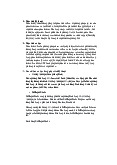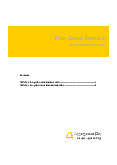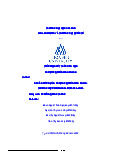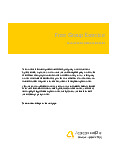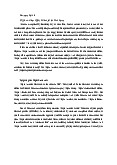



















Preview text:
FACULTY OF BUSINESS ADMINISTRATION INTERNATIONAL MARKETING CODE: MK302DE01 CLASS 0200 _ GROUP 2 FINAL REPORT TOPIC: BITI’S SHOES EXPORT PROCESS TO KOREA
List of students performing: 1. Trần Anh Tú - 2194039
2. Trần Hàng Vĩ Khang - 2195561
3. Thạch Nhật Quang - 2197508
4. Nguyễn Phát Huy - 2196452
5. Nguyễn Quang Khải - 2194450
6. Đinh Hoàng Long - 2196864
Professional Instructor: Ms. Đặng Trương Thuỳ Anh 17/08/2022
FACULTY OF BUSINESS ADMINISTRATION INTERNATIONAL MARKETING CODE: MK302DE01 CLASS 0200 _ GROUP 2 FINAL REPORT TOPIC: BITI’S SHOES EXPORT PROCESS TO KOREA
List of students performing: 7. Trần Anh Tú - 2194039
8. Trần Hàng Vĩ Khang - 2195561
9. Thạch Nhật Quang - 2197508
10. Nguyễn Phát Huy - 2196452
11. Nguyễn Quang Khải - 2194450
12. Đinh Hoàng Long - 2196864
Professional Instructor: Ms. Đặng Trương Thuỳ Anh 17/08/2022 FINAL REPORT 2 | PAGE ABSTRACT
This final report was made by our team to describe the marketing plan and strategy when
bringing Bitis shoes to the Korean market. During the period of making the report, our
group met and exchanged many aspects related to the report, applied the knowledge
learned and searched a lot of information on the internet to apply to the article. this report
thereby offers the most practical plans and strategies to minimize all risks when Bitis enters the Bitis market.
In addition to the knowledge and theory about "International Marketing" that we learned
and cultivated in this short summer, the team also applied the knowledge of some other
subjects such as Marketing basics to SWOT analysis, Biti's customer file segment when
entering the Korean market. The Marketing Strategy and IMC subjects helped my team
develop a specific marketing and communication plan for Bitis. In addition, journals,
books, other references, and related documents on the Internet are also collected and
implemented by our team into the ideas in the report as secondary data sources. FINAL REPORT 3 | PAGE Table of Contents
ABSTRACT..................................................................................................................................... 3
ACKNOWLEDGEMENT ............................................................................................................... 5
TEACHER’S COMMENT .............................................................................................................. 6
LIST OF FIGURE ........................................................................................................................... 7
DESCRIPTION TABLE ................................................................................................................. 8 A.
INTRODUCTION .................................................................................................................. 9 B.
MAIN CONTENT ................................................................................................................ 11 I.
INTRODUCE BITI’S .................................................................................................................. 11 II.
THE MARKET............................................................................................................................. 12 1.
Customer in South Korea .................................................................................................................................... 12 2.
Characteristics of consumer target group .................................................................................................. 12 3.
Consumer preferences and buying habits .................................................................................................. 13 4.
Competition ............................................................................................................................................................... 13 5.
Market size and sales estimates ...................................................................................................................... 15
III. STATEMENT OF PROBLEMS AND OPPORTUNITIES .................................................... 16
1. PESTEL Analysis ............................................................................................................................................................. 16
2. SWOT Analysis of The Company............................................................................................................................. 28
IV. INTERNATIONAL MARKETING OBJECTIVES ..................................................................... 30 1.
Financial objectives: .............................................................................................................................................. 30
2. Market Share Objectives. ............................................................................................................................................ 31
IV. INTERNATIONAL MARKETING PROGRAM ......................................................................... 32
1. Market Segmentation and target market ........................................................................................................... 32
1.1 Demographic segmentation variables .............................................................................................................. 32
1.2. Psychographics segmentation variables ......................................................................................................... 35
2. Marketing Mix .................................................................................................................................................................. 40
Online:....................................................................................................................................................................................... 52
Offline: ...................................................................................................................................................................................... 54
Truth + Motivation + Tension = Insight ...................................................................................................................... 55
VI. EVALUATION AND CONTROL .................................................................................................. 58
B. CONCLUSION ......................................................................................................................... 60
REFERENCE ................................................................................................................................ 61 FINAL REPORT 4 | PAGE ACKNOWLEDGEMENT
First of all, we would like to express our sincere thanks to Hoa Sen University, for
introducing International Marketing into the curriculum. In particular, I would like to
express my deepest gratitude to Ms. Dang Truong Thuy Anh - Lecturer of International
Marketing, thank you for accompanying us during the last semester. Although the class
had to study in the 3rd shift at the beginning of the afternoon, it was quite sleepy, but
with her lectures, her funny way of imparting knowledge made us feel more awake,
excited, and passionate about learning. During the last semester with her valuable
knowledge imparted to us, my friends and I have cultivated a lot of useful knowledge
such as: how to bring a product to the international market, how to research international
markets, how to implement marketing strategies... These are extremely valuable
knowledge for those of us who study Marketing and this knowledge will be the luggage for us to work in the future.
International Marketing is a very good subject, highly practical through real situations.
Ensure to provide the necessary knowledge and skills for our students to apply in real
life. I would like to thank Ms. Thuy Anh for imparting all her knowledge to the students.
However, due to the limited ability to absorb, the knowledge is not broad enough, so
sometimes we will not keep up with what she has to say. Our team has tried our best to
complete the final report this time, but inevitably errors are inevitable. Please consider
and comment so that we can have a better report later. FINAL REPORT 5 | PAGE TEACHER’S COMMENT
………………………………………………………………………………..............
………………………………………………………………………………..............
………………………………………………………………………………..............
………………………………………………………………………………..............
………………………………………………………………………………..............
………………………………………………………………………………..............
………………………………………………………………………………..............
………………………………………………………………………………..............
………………………………………………………………………………..............
………………………………………………………………………………..............
………………………………………………………………………………..............
………………………………………………………………………………..............
………………………………………………………………………………..............
………………………………………………………………………………..............
………………………………………………………………………………..............
………………………………………………………………………………..............
………………………………………………………………………………..............
………………………………………………………………………………..............
………………………………………………………………………………..............
………………………………………………………………………………..............
………………………………………………………………………………..............
………………………………………………………………………………..............
………………………………………………………………………………..............
………………………………………………………………………………..............
………………………………………………………………………………..............
………………………………………………………………………………..............
TPHCM, 15th August 15, 2022
MS. ĐẶNG TRƯƠNG THUỲ ANH FINAL REPORT 6 | PAGE LIST OF FIGURE
Figure 1 ATAR ................................................................................................................. 15
Figure 2 Key Financial Metrics ........................................................................................ 15
Figure 3 GDP Growth ....................................................................................................... 17
Figure 4 Footwear Users in South Korea .......................................................................... 18
Figure 5 Export Volume ................................................................................................... 19
Figure 6 Export Volume ................................................................................................... 20
Figure 7 Export Ranking ................................................................................................... 20
Figure 8 Import Volume ................................................................................................... 21
Figure 9 Import Volume ................................................................................................... 21
Figure 10 Import Volume ................................................................................................. 22
Figure 11 Population by Age ............................................................................................ 32
Figure 12 Income of Korean ............................................................................................. 33
Figure 13 Customer's Usage ............................................................................................. 38
Figure 14 South Korean Footwear Market ....................................................................... 39
Figure 15 Biti's Hunter Running ....................................................................................... 41
Figure 16 Biti's Hunter Running ....................................................................................... 42
Figure 17 Biti's Hunter Running ....................................................................................... 43
Figure 18 Biti's Hunter Running ....................................................................................... 44
Figure 19 KakaoPay .......................................................................................................... 51
Figure 20 BC Card ............................................................................................................ 51
Figure 21 Balance Scorecard ............................................................................................ 59 FINAL REPORT 7 | PAGE DESCRIPTION TABLE Full Name Code Mission Ghi chú Trần Anh Tú 2194039 The Market, ATAR Model, 100%
Evaluation and control (Balance Scorecard), Marketing Mix Thạch Nhật Quang 2197508 Statement of problems and 100% opportunities (PESTEL, SWOT), Marketing Mix Trần Hàng Vĩ Khang 2195561 Marketing Mix 100% Nguyễn Phát Huy 2196452 Marketing Mix, Abstract, 100% Acknowledgement, Conclusion Nguyễn Quang Khải 2194450 Marketing Mix, Market 100%
Segmentation and target market Đinh Hoàng Long 2196864 International marketing 100% objectives, Marketing Mix FINAL REPORT 8 | PAGE A. INTRODUCTION
The main goal of making this report is to help our team have a better overview of how to
bring a company's products to foreign markets. To fulfill the request of Ms. Thuy Anh to
all groups, our team has selected, researched, and written a report on the topic "Bitis
brings sports shoes to the Korean market" related to the article. In general, this is an
opportunity for members to improve their teamwork skills, and learn and research the shoe market in Korea.
In more detail, our 3-year learning has helped us a lot in this report. We analyze the
PESTEL model in Korea to get an overview of the business environment that Bitis is
about to enter, thereby seeing potential opportunities and risks. Analyze the Marketing
Mix so that Bitis understands the real needs of Korean customers to satisfy them most
optimally, thereby making appropriate marketing program plans. Study the Balanced
Scorecard model to establish, implement, monitor, and measure the results of the
proposed strategy, from which you can learn from experience and come up with more effective strategies.
To evaluate the effectiveness and fulfillment of our members, our team has set three
goals, which are presented below: •
Objective 1: the group members do the homework according to the group's progress •
Objective 2: improve skills in researching, analyzing and searching for
information on the internet about the Korean sports shoe market in detail. •
Objective 3: Know how to plan marketing,IMC, PR, market assessment… in the most optimal way
This final report was made by our team to describe the marketing plan and strategy when
bringing Bitis shoes to the Korean market. During the period of making the report, our
group met and exchanged many aspects related to the report, applied the knowledge
learned and searched a lot of information on the internet to apply to the article. this report
thereby offers the most practical plans and strategies to minimize all risks when Bitis enters the Bitis market. FINAL REPORT 9 | PAGE
In addition to the knowledge and theory about "International Marketing" that we learned
and cultivated in this short summer, the team also applied the knowledge of some other
subjects such as Marketing basics to SWOT analysis, Biti's customer file segment when
entering the Korean market. The Marketing Strategy and IMC subjects helped my team
develop a specific marketing and communication plan for Bitis. In addition, journals,
books, other references, and related documents on the Internet are also collected and
implemented by our team into the ideas in the report as secondary data sources. FINAL REPORT 10 | PAGE B. MAIN CONTENT I. INTRODUCE BITI’S
Biti's was established in 1982, the predecessor of Biti's was two production complexes
Van Thanh and Binh Tien with 20 people specializing in the production of rubber
sandals. The two complexes were merged into a Binh Tien rubber cooperative - which
specializes in producing high-quality rubber footwear, which is sold domestically and
exported to the European market.
The unstable political situation in Eastern Europe at the end of 1980 caused Biti's export
market share to decline seriously and Biti's also suffered fierce competition from Thai
and Chinese firms in the Vietnamese market. After learning about Taiwan's EVA
technology, Biti's decided to buy a production line and bring it back to Vietnam. Biti's
registered and protected the trademark in Vietnam to penetrate the domestic market, and
at the same time selecting the main export market for this period is neighboring China.
For consumers to rest assured that they do not have to buy or pay a price when buying
Biti's products, the company also applies a "one price" policy which is well received by many customers.
Biti's shoe distribution system is spread all over the country from South to North with 7
branch centers, 156 stores, and more than 1500 intermediaries distributing retail products,
with the size of the company, it has created jobs. jobs for more than 9,000 workers in
provinces and cities. In China, the world's most populous market, Biti's has set up 4
representative offices with 30 total sales, with more than 300 points of sale Biti's
gradually bring Biti's products to dominate this fertile market. In Cambodia, Biti's has an
official distributor, Cambo Trading, which distributes Biti's products throughout
Cambodia. Besides, Biti's has also been present in major countries such as the UK,
France, USA, Japan, Mexico, Russia... In addition, Biti's is also the face of international
customers with famous brands such as Clarks, Speedo, Skechers, and Lotto,... trusting to
choose to become a processing partner with many orders of great value FINAL REPORT 11 | PAGE II. THE MARKET
1. Customer in South Korea
Consumer demand for Vietnamese goods is also relatively high. On June 8, 2015 in
Seoul, Korea, the Ministry of Industry and Trade cooperated with Emart Group to
organize the opening of Vietnam Goods Week at the Emart supermarket system. Emart's
representative said that Vietnamese products such as seafood, coffee, towels, clothes,
dining tables and chairs ... of Vietnam at Emart are favored by Korean consumers
because they are suitable for the tastes of consumers. Made in Korea, guaranteed quality
and affordable price. When the Vietnam - Korea Free Trade Agreement officially takes
effect (temporary), it opens up many opportunities for Vietnamese products to be more
present in the Korean market. (Makinen, 1971)
2. Characteristics of consumer target group
South Korea's population is rapidly aging, with a median age of 44.8 years. While just
14.8% of the citizenry is under the age of 18, 67.8% is between the ages of 18 and 64,
and 17.5% is over the age of 65. (Data Reportal, 2022). According to the most recent
Wor South Korea's population is rapidly aging, with a median age of 44.8 years. While
just 14.8% of the citizenry is under the age of 18, 67.8% is between the ages of 18 and
64, and 17.5% is over the age of 65. (Data Reportal, 2022). According to the most recent
World Bank data, the population is increasing at a 0.1% annual rate. In 2021, households
will have an estimate of 2.4 people (Kostat). Only 27% of households have one person,
48% have two or three people, 24% have four or five people, and only 1.5% have more
than six people (UN, latest data available). The gender ratio is one man to one woman,
and urban areas are home to 81.5% of such population (Data Reportal, 2022). A
population is focused in the non-mountainous lowlands: the most densely populated
province is Gyeonggi, which surrounds Seoul, while the least densely populated province
is Gangwon. Seoul, Busan, Incheon, Daegu, Daejon, and Gwangju are the major cities.
The standard of education is quite high. In Korea, 89% of adults aged 25 to 64 have
completed secondary education, compared to 79% in the rest of the world (OECD, 2020).
Furthermore, the population with higher education aged 25-34 is expected to be well
almost 70% in 2020, far exceeding the OECD average (45%). Administration and
accounting are the most active professions in the labor force, followed by salespeople and FINAL REPORT 12 | PAGE
kitchen and restaurant workers. Then there are the administrators, office workers, and farmers. (Makinen, 1971).
3. Consumer preferences and buying habits
South Korea is a consumer culture. Purchases are made not only to meet basic needs, but
also to improve one's image and status. The economic slowdown and high level of debt
have prompted some Koreans to exercise caution in their spending, even though luxury
goods remain fashionable. The most popular products are successful brands with visible
detailing. Consumption is being used to make a point. Generally, purchases are made in
department stores, shopping malls, and new types of stores (example: food retailers).
Korean consumers are not brand loyal; they are tech-savvy and concerned with brand
names. Koreans are extremely connected. In fact, more than 98% of South Korean
households use the internet on a daily basis, and more than 85% of the Korean population
owns a smartphone (Data Reportal, 2022). Online shopping has become extremely
democratized. E-commerce platforms are used by approximately 90% of the country's
population, and this figure is expected to rise to 94.4% by 2023. The internet also allows
you to look up information about a product before purchasing it in a store. Social media
platforms are used to research, review, and purchase products. Influencers and product
testers are influential in consumer choices. Consumers are becoming less interested in
domestic products, while purchases of foreign goods are increasing. (SA, SOUTH
KOREA: REACHING THE CONSUMER, 2022) 4. Competition 4.1 Shoopen
SHOOPEN can also be found almost anywhere in major cities. SHOOPEN shoes are
extremely inexpensive. This brand also provides a wide variety of styles suitable for
everyone, from the elderly to children, such as white sneakers, athletic shoes, leather boots, snow shoes, and so on. FINAL REPORT 13 | PAGE 4.2 FILA
Fila has very popular sports brand ambassadors who have effectively promoted their
brand. The innovative use of combining different cloth components to create unique
sportswear was a huge success. Fila's brand image is very successful because of its
motivational designs. They have a very good name for their brand logo because it is
colorful and easily identifiable. The company operates over 100 stores worldwide. Since
its inception in 1911, the brand has left a strong legacy. Fila has expanded into clothing
and children's clothing, in addition to shoes. 4.3 KOLCA
This company is comparable to the American athletic company Vans. Anyway,
youngsters and university kids in Korea are currently quite fond of this brand. KOLCA's
design prioritizes ease of use. KOLCA doesn't employ a variety of hues. This makes
these sneakers ideal for daily wear. These sneakers are really trendy and sporty.
When compared to other brands like SHOOPEN, KOLCA is not as inexpensive.
However, the brand is flourishing in Korea, where several young Koreans have turned
into devoted patrons. Customers can now choose from a wide selection of sneakers and
clothing thanks to the brand's ongoing expansion of its product lines. FINAL REPORT 14 | PAGE
5. Market size and sales estimates
For our Sale estimates, we based on the available market size of 2,700.00 and have the following estimates: - Total sales (units) - Total sales revenue - Gross Margin profit
- Investment Cost: Initial investment and Promotional Spend Figure 1 ATAR
Figure 2 Key Financial Metrics FINAL REPORT 15 | PAGE
III. STATEMENT OF PROBLEMS AND OPPORTUNITIES 1. PESTEL Analysis 1.1 Political
1.1.1 Political structure
South Korea follows a republican political system with the head of the country being the
president. The president is directly elected by the people every five years and is not
allowed to be re-elected. Like most other countries, South Korea follows a three-way
system that is separated between the executive, legislative (National Assembly), and
judiciary. (SA, SOUTH KOREA: ECONOMIC AND POLITICAL OUTLINE, 2022) 1.1.2 Political climate
Yoon Suk-yeol, who received 48.56 percent of the vote, was voted the victor and will
take office as president on March 9th, 2022. Mr. Yoon supports market-based strategies
for promoting economic growth, and the Korean government would extend its policy
support without restriction. This will promote the growth of the footwear business. 1.1.3 Political stability
The government is attempting to create the foundation for economic unification in its
five-year plan by resuming inter-Korean collaboration and looking for a single market for
Seoul and Pyongyang. By 2045, peace and union are to be attained. Biti’s will profit
more if Seoul and Pyongyang agree to establish a joint market. (SA, SOUTH KOREA:
ECONOMIC AND POLITICAL OUTLINE, 2022) 1.1.4 Assessment
South Korea carried out reforms and practiced economic liberty. The country's growth
rate has stabilized at an average rate, and financial conditions are favorable as a result of
quick and effective political action. South Korea's development is significantly
influenced by continuing government influence. Additionally, South Korea established FINAL REPORT 16 | PAGE
diplomatic ties with 191 nations (2019). The political system in South Korea improved in
effectiveness, centered on economic growth, and attracted international capital. 1.2 Ecomonics 1.2.1 GDP growth
Even though China's supply chain disruptions and Russia's war on Ukraine drove up
energy prices, South Korea's Gdp increased by 0.7% in the three months to June 2022, up
from the 0.6% growth in the prior quarter. Both the outcome and the 2.9% yearly increase
in the gross domestic product were better than expected by economists. (Korea T. B.,
South Korea GDP Growth Rate, 2022) Figure 3 GDP Growth FINAL REPORT 17 | PAGE
1.2.2 Korea trading statistics
Footwear Users in South Korea: The average volume of footwear sold per person in
Korea is anticipated to reach 2.9 pairs in 2022. High GDP has an impact on the market
today. Users are increasing year by year, this is the advantage for Biti s ’ to enter this market (Statista, 2022)
Figure 4 Footwear Users in South Korea FINAL REPORT 18 | PAGE 1.2.3 Export
Statistics data, charts on exports and export footwear in the Korean market in recent
years, show the volatility of the market.
Export: From 5773 USD million in June 2022, South Korea's exports grew to 6070 USD
million in July. (Korea T. B., South Korea Exports, 2022) Figure 5 Export Volume
During 2020, South Korea exported footwear, gaiters, and similar items worth
US$408.66 million, according to the UN's COMTRADE database on global commerce.
The data, historical chart, and statistics on South Korea's exports of footwear, gaiters, and
related items were last updated in August of 2022. (Korea T. B., South Korea Exports of Footwear, 2022) FINAL REPORT 19 | PAGE Figure 6 Export Volume
2019's top export destinations for footwear from South Korea include China, Vietnam,
the United States, Japan, and Indonesia. Vietnam ranked 2nd in the top 2019, showing
that Vietnam and Korea have a very good footwear economic relationship, this is also an
opportunity for the footwear market of both countries. (TrendEconomy, 2022)
Figure 7 Export Ranking
In 2020, Korea will export the following major commodity groups of footwear:
69% (71 million US dollars): - Footwear with textile mat uppers and rubber or plastic
outer soles (excluding waterproof footwear).
24% (24 million US dollars): Sports footwear, including gym shoes, training shoes,
tennis shoes, and basketball shoes with outer soles made of rubber or plastic and textile mat uppers. FINAL REPORT 20 | PAGE
